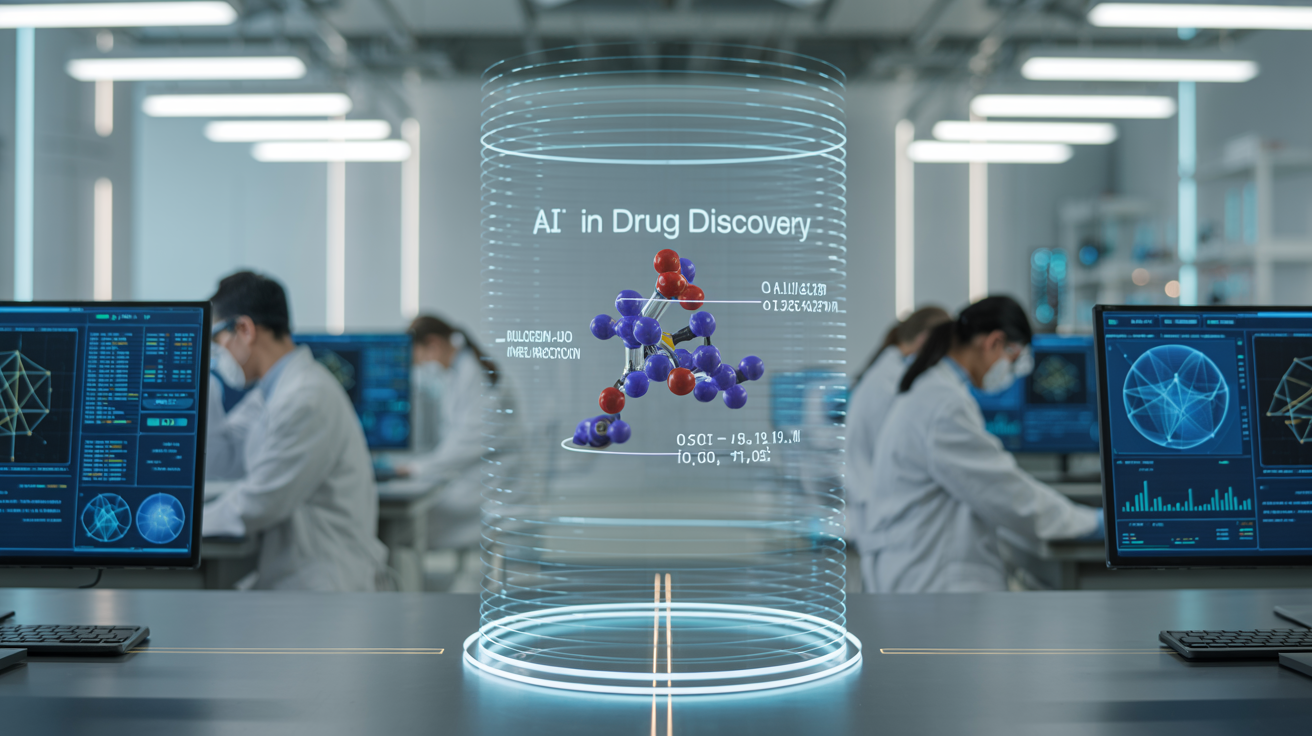Artificial Intelligence (AI) is rapidly becoming a transformative force across various industries, and one of the most impactful areas is healthcare—particularly in drug discovery. Traditionally, discovering a new drug can take 10–15 years and cost billions of dollars. However, AI is changing the equation by making drug discovery faster, cheaper, and more precise.
This article explores how AI accelerates the process of finding new medications, the technologies driving it, real-world applications, challenges, and future prospects.
1. Understanding the Traditional Drug Discovery Process
To grasp the significance of AI in drug discovery, it’s crucial to understand the complexity of the traditional process. The development of a new drug involves several stages:
1.1 Target Identification and Validation
Researchers first identify a biological target (such as a protein or gene) that is associated with a disease.
1.2 Compound Screening
Thousands to millions of chemical compounds are tested to find those that interact with the target.
1.3 Lead Optimization
Promising compounds (leads) are chemically modified to improve their safety, efficacy, and pharmacokinetics.
1.4 Preclinical Testing
Testing is conducted in laboratories and on animals to evaluate the drug’s biological activity and toxicity.
1.5 Clinical Trials
Drugs undergo multi-phase testing on human volunteers to assess safety, efficacy, and dosage.
1.6 Regulatory Approval
After successful trials, regulatory bodies like the FDA or EMA evaluate the drug for public use.
This linear and manual process is costly and has a high failure rate—over 90% of drugs entering clinical trials do not make it to market.
2. How AI is Revolutionizing Drug Discovery
AI transforms nearly every stage of drug development by using machine learning algorithms, natural language processing, and deep learning models to interpret vast amounts of data, identify patterns, and make predictions.
2.1 Target Identification with AI
AI tools analyze genomic, proteomic, and clinical data to discover novel disease targets. For example:
- Machine learning models detect complex patterns across large datasets that are invisible to human researchers.
- AlphaFold by DeepMind predicts 3D structures of proteins with high accuracy, providing essential insights into potential drug targets.
2.2 Virtual Screening and Molecule Design
AI speeds up the compound screening phase significantly:
- Virtual screening allows AI to predict how millions of compounds will interact with a target, eliminating unviable candidates early.
- De novo drug design uses algorithms to generate novel chemical structures from scratch with desirable therapeutic properties.
Companies like Atomwise and Insilico Medicine use these technologies to identify drug candidates in days instead of months.
2.3 Lead Optimization and Predictive Modeling
AI plays a pivotal role in optimizing lead compounds by:
- Predicting toxicity and side effects.
- Suggesting structural modifications for better absorption and potency.
- Simulating pharmacokinetics and metabolism in humans.
This dramatically reduces the number of drugs that fail during later-stage development due to toxicity or inefficacy.
3. AI in Preclinical and Clinical Trials
3.1 Enhancing Preclinical Testing
AI can model biological systems to simulate drug behavior, reducing reliance on animal testing. Predictive models assess toxicity and efficacy based on existing chemical and biological data.
3.2 Optimizing Clinical Trial Design
Clinical trials are among the most expensive parts of drug development. AI helps by:
- Patient stratification: Identifying the right patients based on genetic, lifestyle, and health data.
- Real-time monitoring: Using wearable technology and AI analytics to track patient responses.
- Outcome prediction: Simulating trial results before execution to optimize trial parameters.
This leads to shorter trials, fewer adverse events, and more reliable results.
4. Drug Repurposing Through AI
Another exciting use of AI is drug repurposing—finding new uses for existing drugs. AI analyzes data from clinical trials, literature, and real-world patient data to discover new therapeutic applications.
4.1 COVID-19 Case Study
During the COVID-19 pandemic, companies like BenevolentAI identified Baricitinib—a rheumatoid arthritis drug—as a potential treatment for COVID-19. The prediction, driven by AI, was later validated by clinical research and adopted in several treatment protocols.
5. Real-World Applications of AI in Drug Discovery
Here are some leading examples of companies successfully using AI:
5.1 Atomwise
Uses deep learning to predict how small molecules bind to proteins, accelerating the discovery of treatments for diseases like cancer and neurological disorders.
5.2 Insilico Medicine
Combines generative models and reinforcement learning to design new drugs for conditions like fibrosis and cancer.
5.3 DeepMind’s AlphaFold
Revolutionized protein structure prediction—vital for understanding how drugs interact with the human body.
6. Challenges and Ethical Considerations
Despite its promise, AI-driven drug discovery faces several hurdles:
6.1 Data Quality and Standardization
AI systems depend on high-quality, annotated data. Inconsistent or biased datasets can lead to flawed predictions.
6.2 Black Box Problem
Many AI models, especially deep learning ones, are hard to interpret. Regulators and researchers often require transparency to trust the outputs.
6.3 Regulatory Uncertainty
Regulatory bodies are still evolving their frameworks for AI-driven drugs and insights, which can slow adoption.
6.4 Ethical Concerns
Issues around patient privacy, data ownership, and bias in algorithms must be addressed to ensure responsible use of AI in healthcare.
7. The Future of AI in Drug Discovery
As technology continues to advance, we can expect:
7.1 Personalized Medicine
AI will enable the development of drugs tailored to an individual’s genetic and metabolic profile, enhancing effectiveness and reducing side effects.
7.2 Real-Time Adaptive Trials
AI could eventually enable dynamic clinical trials where designs evolve in real-time based on patient responses.
7.3 Integration with Quantum Computing
Combining AI with quantum computing could further revolutionize molecular modeling and speed up simulations that are currently computationally expensive.
Conclusion
AI is not just enhancing drug discovery—it is redefining it. By integrating machine learning, predictive analytics, and automation into every phase of the drug development process, AI significantly reduces time, cost, and risk. While challenges remain, the benefits are compelling: faster discovery, more targeted treatments, and better outcomes for patients.
As regulatory frameworks evolve and ethical concerns are addressed, AI is set to become an indispensable partner in the future of medicine. In the coming decade, it’s likely that many of the drugs we rely on will owe their existence—at least in part—to artificial intelligence.


